Chartbook
#18: Full-Time Poor and Low Income Workers: Demographic Characteristics
and Trends in Health Insurance Coverage, 1996–97 to 2005–06
By William A. Carroll, MA and G. Edward Miller, PhD
Contents
The estimates in this report are based on the
most recent data available from MEPS at the time the report was written.
However, selected elements of MEPS data may be revised on the basis
of additional analyses, which could result in slightly different
estimates from those shown here. Please check the MEPS Web site (www.meps.ahrq.gov)
for the most current file releases.
The mission of AHRQ is to improve
the quality, safety, efficiency, and effectiveness of health care
for all Americans by:
- Using evidence to improve health care.
- Improving
health care outcomes through research.
- Transforming research
into practice.
Executive Summary
Population Overview
- In 2005–06, there were an average annual total of
13.4 million non-elderly adults who worked full
time for the entire year and who had family
incomes lower than 200 percent of the federal
poverty line. (6)
- These full-time low income workers comprised
14.6 percent of the population of 92.3 million
non-elderly adults who worked full time for the
entire year and who were not self-employed. The
remaining full-time workers lived in middle
income (33.7 percent) and high income (51.8
percent) families. (6)
- Full-time low income workers made up 27.4
percent of the population of 49.1 million low
income non-elderly adults in 2005–06. The
remaining low income adults worked part time
and/or part year (37.6 percent) or were
unemployed or not in the labor force (35.0
percent). (7)
- From 1996–97 to 2005–06, the total number of
non-elderly full-time workers increased from 79.3
to 92.3 million and the total number of low income
non-elderly adults increased from 41.6 to 49.1
million. There was no significant change, however,
in the size of the population of full-time low
income workers which numbered 12.8 million in
1996–97 and 13.4 million in 2005–06. (8)
- Among all non-elderly full-time workers,
insurance status varied by income. Full-time low
income workers (56.1 percent) were less likely
than full-time middle income workers (84.9
percent) and high income workers (94.9 percent)
to have private health insurance coverage. Fulltime
low income workers were more likely than
other groups to have public coverage (9.4 percent)
or to be uninsured (34.5 percent). (9)
- From 1996–97 to 2005–06 the proportions of fulltime
workers covered by private health insurance
fell by 10.4 points for low income workers, by
4.3 points for middle income workers and by 1.6
points for high income workers. In the same time
period the proportions with no insurance coverage
increased by 8.5, 3.3, and 1.1 points, respectively,
for low, middle, and high income workers. (10)
Demographic and Job Characteristics of Full-Time
Low Income Workers
- In 2005–06, full-time low income workers were
relatively young (83.4 percent were less than 50
years old), nearly half were Hispanic (32.2 percent)
or black non-Hispanic (17.1 percent), 57.2 percent
were male and about one-third (33.6 percent) had
less than a high school education. Slightly more
than half (51.1 percent) of full-time low income
workers were married, half (50.1 percent) lived in
families with four or more members and about 1 in
10 (11.1 percent) was in fair or poor health. Nearly
one-quarter (23.5 percent) of full-time low income
workers were not U.S. citizens. (12)
- From 1996–97 to 2005–06, there were a number of
significant changes in the demographic
characteristics of full-time low income workers. In
particular, the proportion who were older than 50
increased from 11.6 to 16.6 percent, the proportion
who were Hispanic increased from 23.4 to 32.2
percent, the proportion with less than a high school
education increased from 27.3 to 33.6 percent and
the proportion who were not U.S. citizens increased
from 13.8 to 23.5 percent. (13)
- In 2005–06, 7.9 percent of full-time low income
workers belonged to a union, 45.2 percent worked
in an establishment with fewer than 25 employees,
24.6 percent worked in an establishment with 26 to
99 employees and less than one-third (30.1 percent)
worked in an establishment with 100, or more,
employees. Full-time low income workers were
most likely to work in service industries with 26.4
percent working in professional services
occupations and 18.0 percent working in
leisure/hospitality/other services. (34)
- From 1996–97 to 2005–06, the percentages of fulltime
low income workers declined in the
manufacturing and wholesale/retail trade industries
while the percentages of full-time low income
workers increased in the professional services,
leisure/hospitality/other services and
natural/resources/mining industries.
Health Insurance Status of Full-Time Low Income
Workers
- From 1996–97 to 2005–06, most subgroups
of fulltime low income workers examined in this
Chartbook experienced statistically significant
decreases in the percentage with private health
insurance. Some of the largest declines in private
coverage were experienced by workers who were:
35 to 49 years old (13.1 points), in single person
families (14.2 points), working in natural
resources/mining/construction (18.3 points) or in
professional services (14.5 points). (40, 64)
- Most subgroups with a statistically significant
decline in private health insurance had
corresponding increases in the percentage
uninsured. Some of the largest increases in the
percentage uninsured were experienced by workers
who lived in single person families (14.9 points),
lived in the South (12.2 points) or worked in
professional services (14.9 points). Many
subgroups also had corresponding increases in the
proportion with public health insurance which
mitigated, but did not completely make up for,
losses in private coverage. (56, 64)
- In 2005–06, the subgroups with the lowest rates of
private coverage (and highest rates of uninsured)
included persons who: were Hispanic (40.2
percent), had less than a high school education (41.1
percent), were not U.S. citizens (32.6 percent),
worked in natural resources/mining/construction
(34.1 percent) or in leisure/hospitality/other services
(40.4 percent). As noted above, each of these
subgroups represented a larger portion of the low
income worker population in 2005–06 than in 1996– 97.
(41, 57)
- In 2005–06, the 7.9 percent of low income workers
who were union members had the highest rate of
private insurance coverage (87.6 percent) of any
group examined. There was no statistically
significant change in this percentage from 1996–
97 to 2005–06. (32, 33, 48, 59, 60)
Return to Table of Contents
Foreword
The mission of the Agency for Healthcare Research
and Quality (AHRQ) is to improve the quality, safety, efficiency,
and effectiveness of health care for all Americans. The Medical
Expenditure Panel Survey (MEPS) helps AHRQ fulfill its mission by providing
information
on health care use and expenses, health insurance, health status,
and a variety of demographic, social, and economic characteristics.
MEPS
is a set of large-scale surveys of families and individuals, their
medical
providers, and employers across the United States.
MEPS provides various ways of accessing the data
so that it can be most useful to you. The MEPS Web site (http://www.meps.ahrq.gov)
has:
- Online publications to read or download.
- MEPS public
use data files that you can review and download.
- MEPSnet, which
allows analysis of MEPS
data using online statistical tools.
- Tables showing MEPS
data displayed by some of the most frequently used characteristics.
AHRQ welcomes questions and comments from readers of this publication
who are interested in obtaining more information about access, cost,
use, financing, and quality of health care in the United States. We also
invite you to tell us how you are using this Chartbook and other MEPS
data and tools and to share suggestions on how MEPS products might be
enhanced to further meet your needs. Please e-mail us at mepsprojectdirector@ahrq.hhs.gov or send a letter to the address below:
Steven B. Cohen, PhD
Director
Center for Financing, Access, and Cost Trends
Agency for Healthcare
Research and Quality
540 Gaither Road
Rockville, MD 20850
Return to Table of Contents
Introduction
Employment has long been the primary pathway
to health insurance for non-elderly workers in the United States.
In this employer based system, the health insurance status of low
income workers has often been the focus of public concern and policy
debate. Low income workers are less likely to work in companies
that offer insurance, to be eligible for offered insurance and
to take up coverage when they are eligible. As a consequence, low
income workers are less likely than workers with higher incomes
to have employer sponsored insurance (ESI) and are more likely
to be uninsured. Low income workers are also more vulnerable to
recent changes in ESI such as increased premiums and requirements
for increased employee contributions. Conversely, recent expansions
of SCHIP and other public insurance programs may have a larger
effect on insurance coverage for low income workers as they and
their family members—especially their children— are
more likely than families with higher incomes to be eligible for
expanded public coverage.
This Chartbook examines recent trends
in the health insurance status of non-elderly adult, low income
workers in the United States. We classify adults as ‘low
income’ if their family income is less than 200 percent of
the Federal Poverty Line (FPL). This includes adults in families
with incomes below the FPL as well as adults in families with incomes
between 100 and 200 percent of the FPL. Among these low income
adults, we focus on individuals who were most likely to have access
to ESI. Specifically, we focus on non-elderly adults who worked
full time for the entire year and who were not self-employed. Throughout
we refer to our population of interest as ‘full-time low
income workers.’
The Chartbook is organized into three sections.
Section 1 provides an overview of the income and employment characteristics
for the U.S. civilian noninstitutionalized adult population, places
full-time low income workers in the context of this larger population
and compares the health insurance status of low, middle, and high
income full-time workers. Section 2 presents information on the
demographic characteristics, health status, and job characteristics
of full-time low income workers. Average annual estimates for the
years 2005–06 are presented to provide recent information
on the characteristics of low income workers. Trends, from 1996–97
to 2005–06, are presented to provide information on recent
changes in the composition of low income workers which may have
contributed to changes in their overall health insurance status.
Finally, Section 3 presents information on the health insurance
status of full-time low income workers by demographic, health,
and job characteristics. As in Section 2, we present estimates
for 2005–06, and trends from 1996–97 to 2005–06. Return to Table of Contents
Source of Data
The estimates presented in this report come from the
Medical Expenditure Panel Survey (MEPS). MEPS is a nationally representative
survey of households, collecting detailed information on health status,
health care use and expenses, and health insurance coverage of individuals
and families in the U.S. civilian noninstitutionalized population.
Data for this Chartbook comes from the following MEPS
public use files:
- 1996, 1997, 2005, and 2006 Full Year Consolidated
Data Files
- 1996, 1997, 2005, and 2006 Jobs Files
We pool data from the MEPS for 1996–97 and 2005–06 and compute
average annual estimates based on the pooled data to increase sample sizes
and statistical power. Standard errors are corrected for the complex survey
design of MEPS and for repeated observations for individuals. Differences
that appear large may not always be statistically significant. Only differences
between groups or trends over time that are statistically significant at
the 0.05 level (not likely to be caused by sampling error) are noted in
the text. Return to Table of Contents
Section
1: Population Overview
This section provides an overview of the income and
employment characteristics of non-elderly adults in the U.S. civilian noninstitutionalized
population and provides context for subsequent sections in several ways.
First, this section presents population statistics for full-time low income
workers in the context of larger populations such as all full-time workers
and all low income adults. Second, this section compares the health insurance
status of full-time low income workers to full-time middle and high income
workers.
What was the total population of non-elderly
adults in the U.S. and how were they distributed across income categories
in 2005–06?
- There were an average annual total of 186.1 million
non-elderly adults (18 to 64 years old) in the U.S. civilian
noninstitutionalized population in 2005–06.
- Approximately 51.3 million adults (27.6 percent) lived
in low income families, 57.9 million (31.1 percent) lived in
middle income families and 76.9 million (41.3 percent) lived in high income
families.
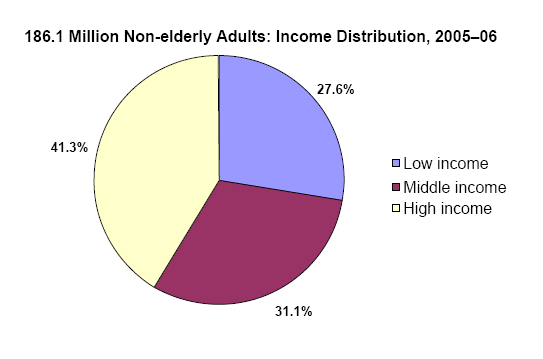
186.1 Million Non-elderly Adults:
Income Distribution, 2005–06 |
Low income |
27.6% |
Middle income |
31.3% |
High income |
41.3% |
Return to Table of Contents
What was the employment status of non-elderly adults
in the U.S. in 2005–06?
- Nearly half, 92.3 million non-elderly adults (49.6 percent),
worked full time for an employer for the entire year. About one-quarter,
50.3 million non-elderly adults (27.1 percent) were employed part
time or part year, 33.7 million (18.1 percent) were either unemployed or
not in the labor force (NLF) and the remaining 9.8 million (5.3 percent)
were self-employed.
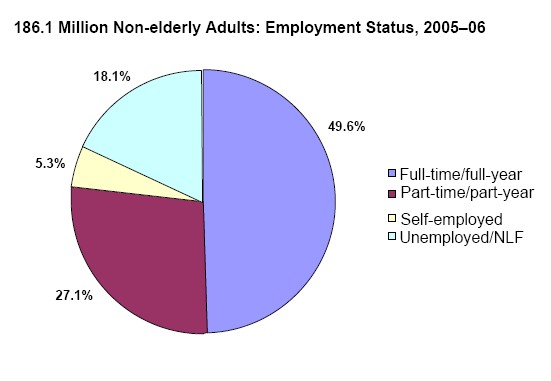
186.1
Million Non-elderly Adults:
Employment Status, 2005–06 |
Full-time/full-year |
49.6% |
Part-time/part-year |
27.1% |
Self-employed |
5.3% |
Unemployed/NLF |
18.1% |
Return to Table of Contents
What was the total population of non-elderly, full-time/full-year
workers, excluding the self-employed, and how were they distributed
across income
categories in 2005–06?
- In 2005–06, there were an average annual total of 13.4 million
non-elderly adults who worked full time for the entire year and who lived
in families
with low incomes (less 200 percent of the Federal Poverty Line).
- These
full-time low income workers comprised 14.6 percent of the
entire population of 92.3 million non-elderly adults who worked full time
for the
entire year and were not self-employed. The remaining full-time
workers lived in middle income (33.7 percent) and high income (51.8 percent)
families.
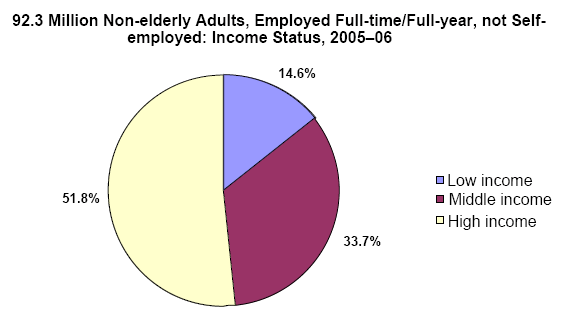
92.3 Million Non-elderly Adults, Employed Full-time/Full-year,
not Self-employed: Income Status, 2005–06 |
Low income |
14.6% |
Middle income |
33.7% |
High income |
51.8% |
Return to Table of Contents
What was the total population of non-elderly low income adults,
excluding the self-employed, and what was their distribution across employment
status
in 2005–06?
- In 2005–06 there were an average annual total of 49.1 million
non-elderly, low income adults.
- The 13.4 million full-time low income workers
comprised about one-quarter (27.4 percent) of the entire low
income non-elderly adult population. This is a lower percentage than in
the overall
population
of non-elderly adults, in which nearly half (49.6 percent) of all
adults were employed full time for the full year.
- Approximately 18.5
million or 37.6 percent of non-elderly low income adults were
working either part time or part year and 17.2 million or 35.0 percent
were either unemployed
or not in the labor force.
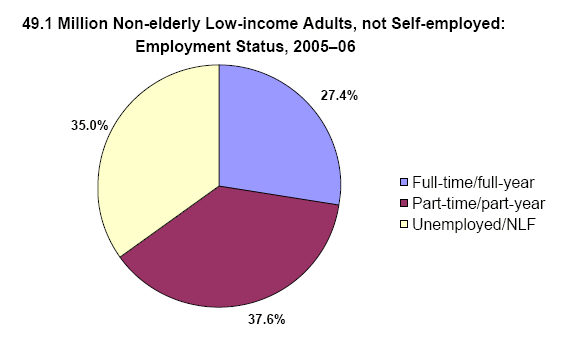
49.1 Million Non-elderly
Low-income Adults, not Self-employed:
Employment Status,
2005–06 |
Full-time/full-year |
27.4% |
Part-time/part-year |
37.6% |
Unemployed/NLF |
35.0% |
Return to Table of Contents
Did the population of full-time workers and the population of low
income non-elderly adults change from 1996–97 to 2005–06?
- The population of full-time/full-year workers increased by 13.0 million
or 16.4 percent, from an average annual total of 79.3 million
in 1996–97
to 92.3 million in 2005–06.
- The population of low income adults increased by 7.5 million or 18.0
percent, from an average annual total of 41.6 million in 1996–97 to 49.1 million
in 2005–06.
- In spite of this population growth, there was no statistically significant
change in the total population of full-time low income workers
which numbered 12.8 million persons in 1996–97 and 13.4 million in 2005–06.
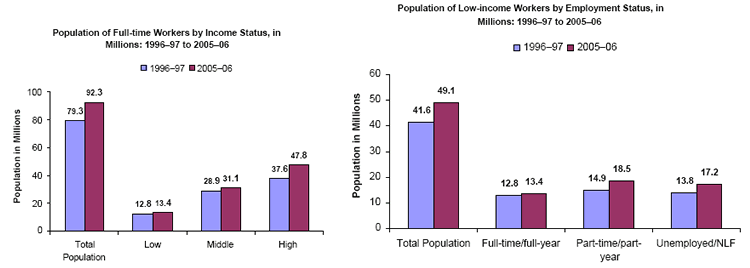
Population
of Full-time Workers by Income Status,
in Millions: 1996–97 to 2005–06 |
| |
1996-97 |
2005-06 |
Total Population |
79.3 |
92.3 |
Low |
12.8 |
13.4 |
Middle |
28.9 |
31.1 |
High |
37.6 |
47.8 |
Population
of Low-income Workers by Employment Status,
in Millions:
1996–97 to 2005–06 |
| |
1996-97 |
2005-06 |
Total Population |
41.6 |
49.1 |
Full time/full year |
12.8 |
13.4 |
Part time/part-year |
14.9 |
18.5 |
Unemployed/NLF |
13.8 |
17.2 |
Return to Table of Contents
Did the sources of health insurance coverage for non-elderly, full-time/full-year
workers, excluding the self-employed, vary across income categories
in 2005–06?
- Full-time low income workers were much less likely than others to have
private health insurance. Only 56.1 percent of low income workers
had private health insurance compared to 84.9 percent of middle income
and 94.9 percent
of high income workers.
- Full-time low income workers were more likely to have public health
insurance than middle income and high income workers (9.4 percent compared
to
1.9 percent and 1.1 percent, respectively).
- Full-time low income
workers were much more likely to be uninsured than others.
More than one-third (34.5 percent) of all low income workers (4.6 million
persons) were uninsured
compared to 13.2 percent of middle income and 4.0 percent of
high income workers.

Insurance
Status by Family Income, 2005–06 |
| |
Low income |
Middle income |
High income |
Uninsured |
34.5% |
13.2% |
4.0% |
Public insurance only |
9.4% |
1.9% |
1.1% |
Any private insurance |
56.1% |
84.9% |
94.9% |
Return to Table of Contents
Did the sources of health insurance coverage for low, middle, and
high income non-elderly workers change from 1996–97 to 2005–06?
- The proportion of full-time low income workers with private health insurance
fell by 10.4 points from 66.5 percent in 1996–97 to 56.1 percent in
2005–06. Middle and high income workers also had significant declines
in the proportion with private insurance (declines of 4.3 points
and 1.6 points, respectively).
- The proportion of low income workers with
public health insurance increased by 2.0 points from 7.4 percent
in 1996–97
to 9.4 percent in 2005–06. Middle and high income workers also had
significant increases in the proportion covered by public health
insurance in this time period (increases of 0.9 points and 0.5 points,
respectively).
- The
proportion of low income workers who were uninsured increased
by 8.5 points (1.3 million persons) from 26 percent in 1996–97 to 34.5 percent in
2005–06. Middle income and high income workers also had increases
in the proportion uninsured (increases of 3.3 points and 1.1 points,
respectively).
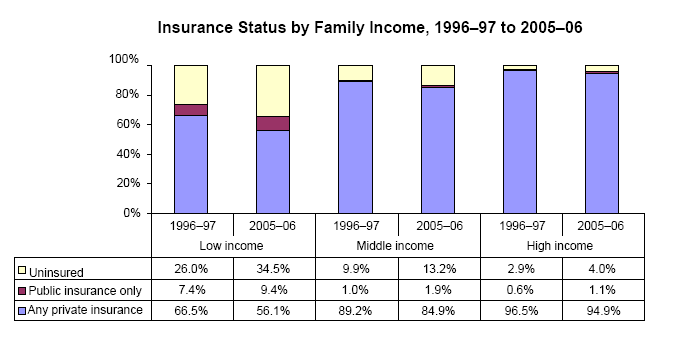
Insurance
Status by Family Income, 1996–97 to 2005–06 |
| |
Low income
1996-97 |
Low income
2005-06 |
Middle income
1996-97 |
Middle income
2005-06 |
High income
1996-97 |
High income
2005-06 |
Uninsured
|
26.0% |
34.5% |
9.9% |
13.2% |
2.9% |
4.0% |
Public insurance only
|
7.4% |
9.4% |
1.0% |
1.9% |
0.6% |
1.1% |
Any private insurance
|
66.5% |
56.1% |
89.2% |
84.9% |
96.5% |
94.9% |
Return to Table of Contents
Section 2: Demographic
Characteristics, Health Status, and Job Characteristics of Low Income
Workers In
this section we focus exclusively on our population of interest, non-elderly,
full-time low income workers. This group comprised non-elderly adults
(ages 18 to 64) who were employed full time for the entire year, who
were not self-employed and whose family income was less than 200 percent
of the Federal Poverty Line. We examine the distribution of full-time
low income workers across demographic characteristics, health status,
and job characteristics in 2005–06 and trends in these distributions
from 1996–97 to 2005–06.
What were the ages of non-elderly low income workers in 2005–06?
- Low income workers were more likely to be in one of the younger age groups,
18 to 34 or 35 to 49, than in the oldest age group, 50 to 64. About
5.6 million persons (41.5 percent) were 18 to 34, 5.6 million (41.9 percent)
were 35 to 49 and 2.2 million (16.6 percent) were 50 to 64 years old.
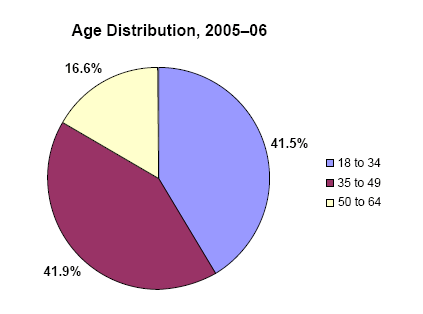
Age
Distribution, 2005–06 |
18 to 34 |
41.5% |
35 to 49 |
41.9% |
50 to 64 |
16.6% |
Return to Table of Contents
Did the age distribution of non-elderly full-time low income workers
change from 1996–97 to 2005–06?
The proportion of full-time low income workers ages 18 to 34 decreased
by 6.2 points, from 47.7 percent in 1996–97 to 41.5 in 2005–06.
In the same period, the proportion of workers ages 50 to 64 increased
by 5.0 points (from 11.6 to 16.6 percent).
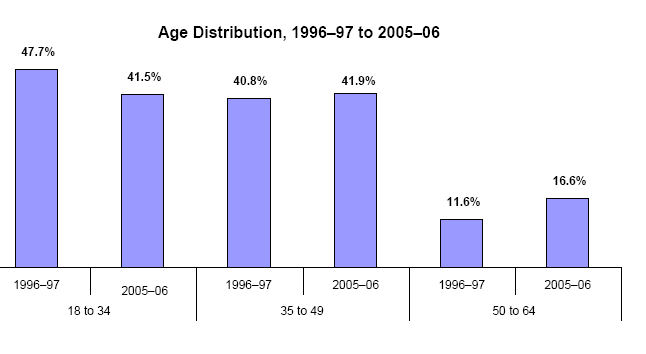
Age
Distribution, 1996–97 to 2005–06
|
18 to 34
1996-97
|
18 to 34
2005-06
|
35 to 49
1996-97
|
35 to 49
2005-06
|
50 to 64
1996-97
|
50 to 64
2005-06
|
| 47.7% |
41.5% |
40.8% |
41.9% |
11.6% |
16.6% |
Return to Table of Contents
What was the racial/ethnic composition of non-elderly full-time
low income workers in 2005–06?
- About 4.3 million or nearly one-third of all low income workers were Hispanic,
2.3 million (17.1 percent) were black non-Hispanic and the remaining
6.8 million (50.7 percent) were classified as white/other non-Hispanic.
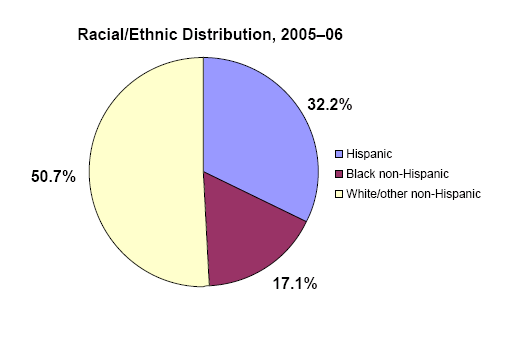
Racial/Ethnic
Distribution, 2005–06 |
Hispanic |
32.2% |
Black non-Hispanic |
17.1% |
White/other non-Hispanic |
50.7% |
Return to Table of Contents
Did the racial/ethnic composition of non-elderly full-time low
income workers change between 1996–97 and 2005–06?
- The proportion of full-time low income workers who were Hispanic increased
by 8.8 points from 23.4 percent in 1996–97 to 32.2 percent in 2005–06
while the proportion in the white/other non-Hispanic category fell
by 7.0 points.
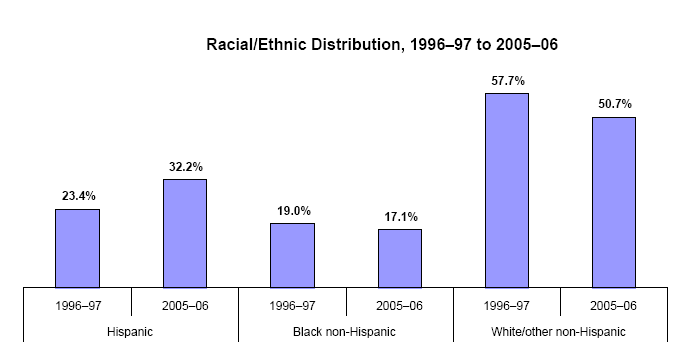
Racial/Ethnic
Distribution, 1996–97 to 2005–06
|
Hispanic
1996-97 |
Hispanic
2005-06 |
Black
non-Hispanic
1996-97 |
Black
non-Hispanic
2005-06 |
White/other
non-Hispanic
1996-97 |
White/other
non-Hispanic
2005-06 |
| 23.4% |
32.2% |
19.0% |
17.1% |
57.7% |
50.7% |
Return to Table of Contents
What was the percentage distribution across sexes for non-elderly,
full-time low income workers in 2005–06?
- Full-time low income workers were more likely to be male than
female (57.2 percent and 42.8 percent, respectively), with 1.9 million more
men than women.
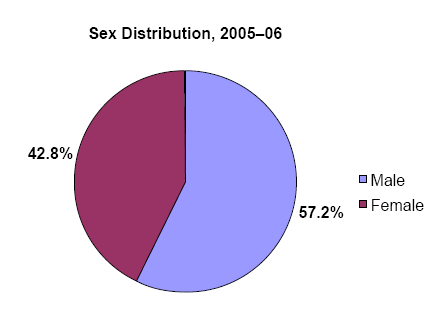
| Sex Distribution, 2005–06 |
Male |
57.2% |
Female |
42.8% |
Return to Table of Contents
Did the percentage of men, or women, non-elderly full-time low
income workers change between 1996–97 and 2005–06?
- There were no statistically significant changes in the percentage distribution
of full-time low income workers across sexes.
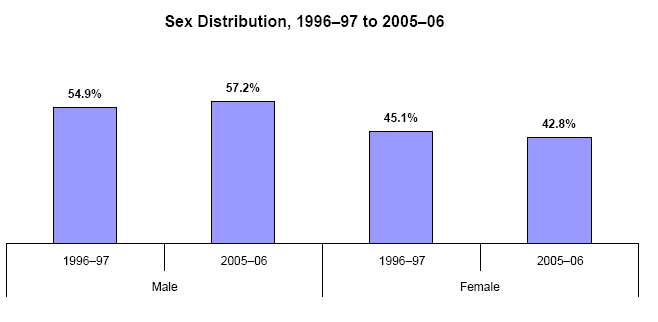
Sex
Distribution, 1996–97 to 2005–06
|
Male
1996-97 |
Male
2005-06 |
Female
1996-97 |
Female
2005-06 |
| 54.9% |
57.2% |
45.1% |
42.8% |
Return to Table of Contents
What levels of education did non-elderly full-time low income workers
have in 2005–06?
- Slightly more than a third (33.6 percent) had less than a high school diploma,
41.0 percent were high school graduates and a little more than a quarter
(25.4 percent) had at least some college.

| Educational Status, 2005–06 |
Less than high school |
33.6% |
High school grad |
41.0% |
At least some college |
25.4% |
Return to Table of Contents
Did the education level of non-elderly full-time low income workers
change from 1996–97 to 2005–06?
- The proportion with less than a high school diploma increased by 6.3
points from 27.3 percent in 1996–97 to 33.6 percent in 2005–06,
while the percentage with at least some college decreased by 3.7
points, from 29.1 to 25.4 percent.
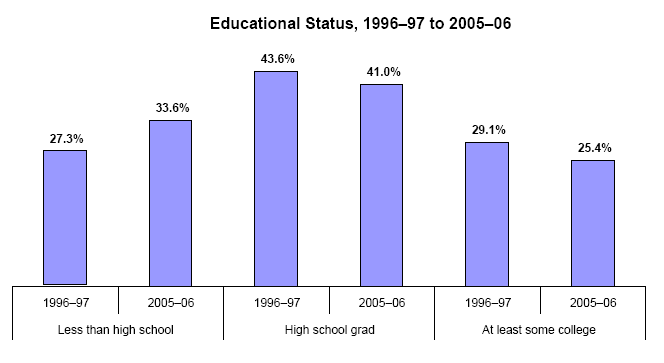
Educational
Status, 1996–97 to 2005–06
|
Less than high school
1996-97 |
Less than high school
2005-06 |
High school grad
1996-97 |
High school grad
2005-06 |
At least some college
1996-97 |
At least some college
2005-06 |
| 27.3% |
33.6% |
43.6% |
41.0% |
29.1% |
25.4% |
Return to Table of Contents
What percentage of non-elderly full-time low income workers were
married in 2005–06?
- Full-time low income workers were almost evenly divided between those that
were married and those that were unmarried.
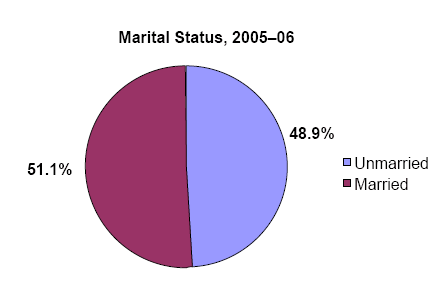
Marital
Status, 2005–06 |
Unmarried |
48.9% |
Married |
51.1% |
Return to Table of Contents
Did the percentage of non-elderly full-time low income workers
who were married change between 1996–97 and 2005–06?
- There was not a statistically significant change in the percentage married
in the two time periods.
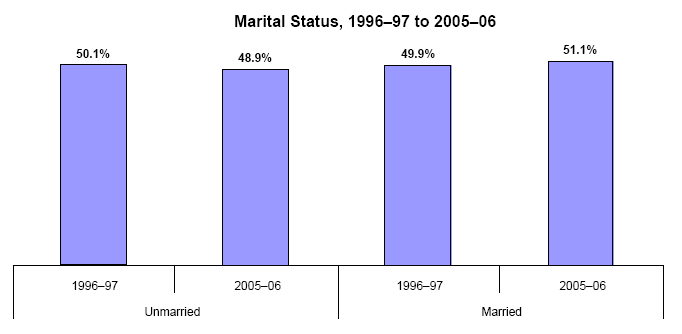
Marital
Status, 1996–97 to 2005–06
|
Unmarried
1996-97 |
Unmarried
2005-06 |
Married
1996-97 |
Married
2005-06 |
| 50.1% |
48.9% |
49.9% |
51.1% |
Return to Table of Contents
What were the family sizes of non-elderly full-time low income
workers in 2005–06?
- Slightly more than half (50.1 percent) of low income workers were in families
with four or more persons while 16.8 percent were single person units, 18.0
percent were in two person families and 15.2 percent were in three person
families.
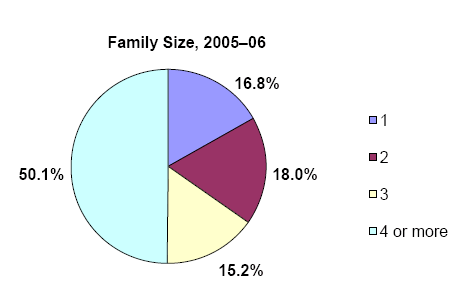
Family
Size, 2005–06 |
1 |
16.8% |
2 |
18.0% |
3 |
15.2% |
4 or more |
50.1% |
Return to Table of Contents
Did the family sizes of non-elderly full-time low income workers
change from 1996–97 to 2005–06?
- There were no statistically significant changes in the percentages of full-time
low income workers in different family sizes in these two time periods.

Family
Size, 1996–97 to 2005–06
|
1996-97
Number of Family Members 1 |
2005-06
Number of Family Members 1 |
1996-97
Number of Family Members 2 |
2005-06
Number of Family Members 2 |
1996-97
Number of Family Members 3 |
2005-06
Number of Family Members 3 |
1996-97
Number of Family Members 4 or more |
2005-06
Number of Family Members 4 or more |
| 18.8% |
16.8% |
17.2% |
18.0% |
16.6% |
15.2% |
47.3% |
50.1% |
Return to Table of Contents
What percentage of non-elderly full-time low income workers were
in fair or poor health in 2005–06?
- Slightly more than 1 in 10 (11.1 percent) full-time low income workers
were in fair or poor health.
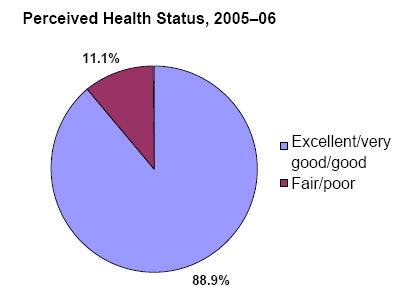
Perceived
Health Status, 2005–06 |
Excellent/very good/good |
88.9% |
Fair/poor |
11.1% |
Return to Table of Contents
Did the percentage
of non-elderly full-time low income workers in fair or poor health change
from 1996–97
to 2005–06?
- There was not a statistically significant change in the percentage of full-time
low income workers who were in fair or poor health in these two time periods.
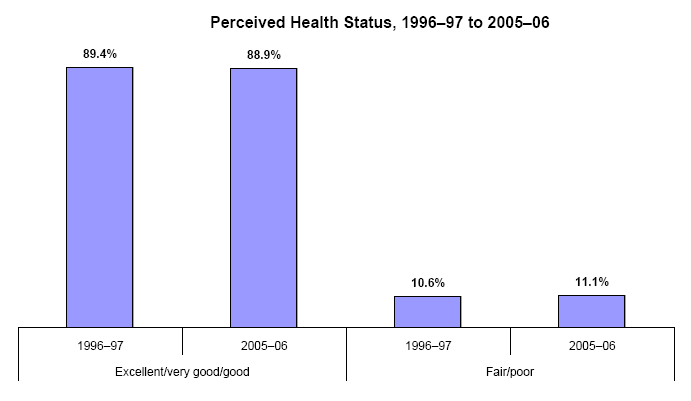
Perceived
Health Status, 1996–97 to 2005–06
|
Excellent/very good/
good
1996-97 |
Excellent/very good/
good
2005-06 |
Fair/poor
1996-97 |
Fair/poor
2005-06 |
| 89.4% |
88.9% |
10.6% |
11.1% |
Return to Table of Contents
What percentage of non-elderly full-time low income workers lived
in an MSA in 2005–06?
- Nearly 8 in 10 (79.6 percent)
full-time low income workers lived in a Metropolitan Statistical Area
(MSA).

MSA
Status, 2005–06 |
MSA |
79.6% |
Non-MSA |
20.4% |
Return to Table of Contents
Did the percentage of non-elderly full-time low income workers
living in an MSA change from 1996–97 to 2005–06?
- There was not a statistically significant change in the percentage living
in an MSA.
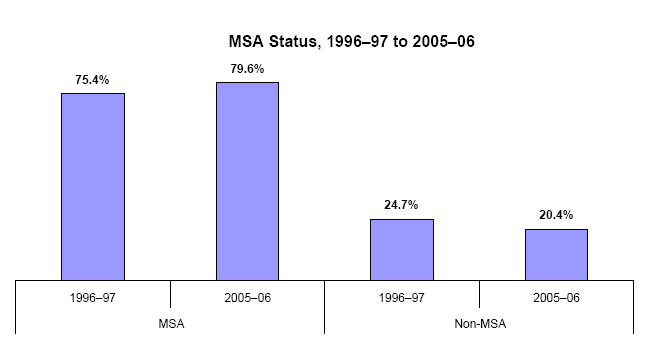
MSA Status,
1996–97 to 2005–06
|
MSA
1996-97 |
MSA
2005-06 |
Non-MSA
1996-97 |
Non-MSA
2005-06 |
| 75.4% |
79.6% |
24.7% |
20.4% |
Return to Table of Contents
How were non-elderly full-time low income workers distributed across
the Census regions in 2005–06?
- Full-time low income workers were most likely to live in the South (44.1
percent) and least like to live in the Northeast (14.0 percent).
Slightly less than a quarter (23.5 percent) lived in the West and 18.4 percent
lived in the Midwest.
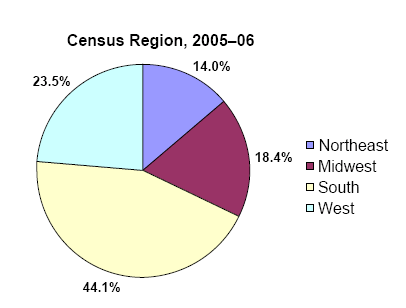
Census
Region, 2005–06 |
Northeast |
14.0% |
Midwest |
18.4% |
South |
44.1% |
West |
23.5% |
Return to Table of Contents
Has the distribution of non-elderly full-time low income workers
across Census regions changed from 1996–97 to 2005–06?
- There was not a statistically significant change in the percentages of
low income workers living in each of the Census regions.
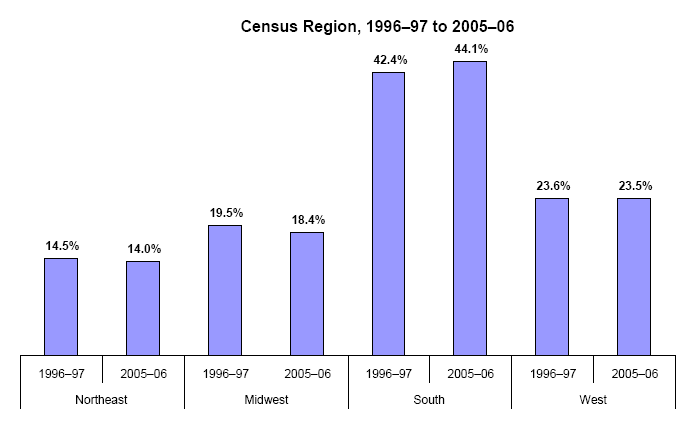
Census
Region, 1996–97 to 2005–06
|
1996-97
Northeast |
2005-06
Northeast |
1996-97
Midwest
|
2005-06
Midwest |
1996-97
South
|
2005-06
South |
1996-97
West
|
2005-06
West |
| 14.5% |
14.0% |
19.5% |
18.4% |
42.4% |
44.1% |
23.6% |
23.5% |
Return to Table of Contents
What percentage of non-elderly full-time low income workers were
not U.S. citizens in 2005–06?
- Nearly 1 in 4 (23.5 percent) full-time low income workers were not U.S.
citizens in 2005–06.
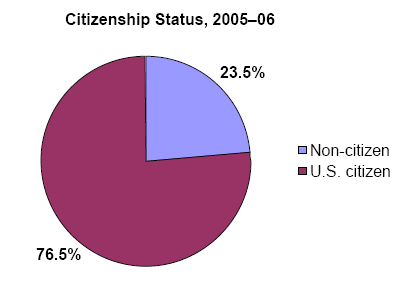
Citizenship
Status, 2005–06 |
Non-citizen |
23.5% |
U.S. citizen |
76.5% |
Did the proportion
of non-elderly full-time low income workers who were not citizens change
from 1996–97 to 2005–06?
- The proportion of full-time low income workers that were not U.S. citizens
increased by 9.7 points, from 13.8 percent in 1996–97 to 23.5 percent
in 2005–06.
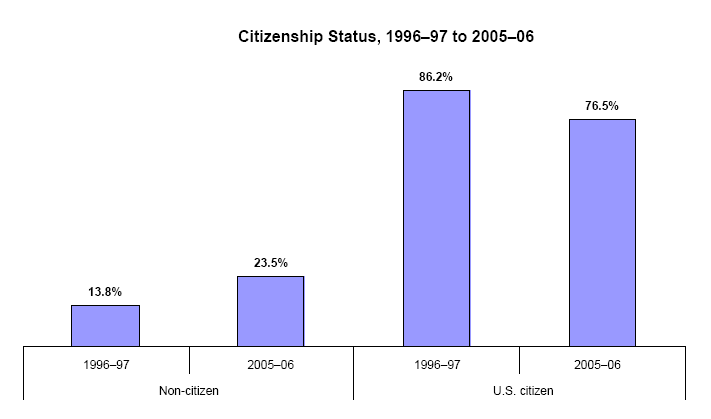
Citizenship
Status, 1996–97 to 2005–06
|
1996-97
Non-citizen
|
2005-06
Non-citizen |
1996-97
U.S. citizen |
2005-06
U.S. citizen |
| 13.8% |
23.5% |
86.2% |
76.5% |
Return to Table of Contents
What percentage of non-elderly full-time low income workers were
union members in 2005–06?
- Less than 1 in 10 (7.9 percent) full-time low income workers were
union members in 2005–06.

| Union Membership, 2005–06 |
Non-union |
92.1% |
Union |
7.9% |
Return to Table of Contents
Did the percentage of non-elderly full-time low income workers
belonging to unions change from 1996–97 to 2005–06?
- There was not a statistically significant change in the percentage of full-time
low income workers belonging to a union in these two time periods.

Union Membership,
1996–97 to 2005–06
|
1996-97
Non-union
|
2005-06
Non-union |
1996-97
Union |
2005-06
Union |
| 90.2% |
92.1% |
9.8% |
7.9% |
Return to Table of Contents
How were non-elderly full-time low income workers distributed across
small, medium, and large establishments in 2005–06?
- Full-time low income workers were most likely to be working in establishments
with less than 25 employees (45.2 percent) while 24.6 percent worked in
establishments with 25 to 99 employees, and 30.1 percent worked in establishments
with 100 or more employees.
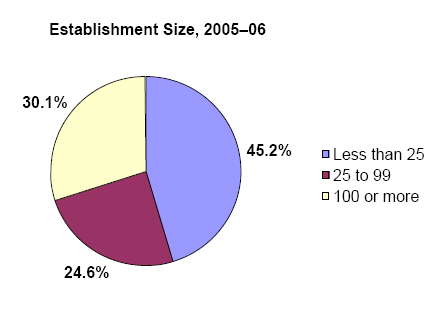
Establishment
Size, 2005–06 |
Less than 25 |
45.2% |
25 to 99 |
24.6% |
100 or more |
30.1% |
Return to Table of Contents
Did the distribution
of non-elderly full-time low income workers across small, medium, and
large establishments
change from 1996–97 to 2005–06?
- There were no statistically significant changes in the distribution of
workers across small, medium, and large establishments.
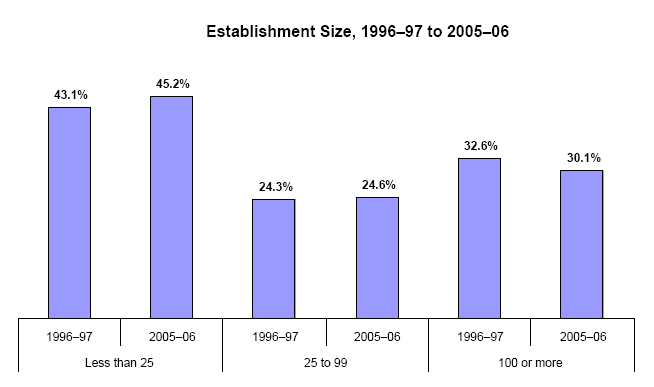
Establishment
Size, 1996–97 to 2005–06
|
1996-97
Less than 25 |
2005-06
Less than 25 |
1996-97
25 to 99 |
2005-06
25 to 99 |
1996-97
100 or more |
2005-06
100 or more |
| 43.1% |
45.2% |
24.3% |
24.6% |
32.6% |
30.1% |
Return to Table of Contents
In which industries were non-elderly full-time low income workers
employed in 2005–06?
- Full-time low income workers were most likely to be employed in professional
services (26.4 percent), followed by leisure/hospitality/other
services (18.0), with the remaining 55.6 percent relatively evenly distributed
among
manufacturing (13.7 percent), natural resources/mining/construction
(14.8 percent), wholesale/retail trade (14.5 percent) and "other" industries
(12.5 percent).
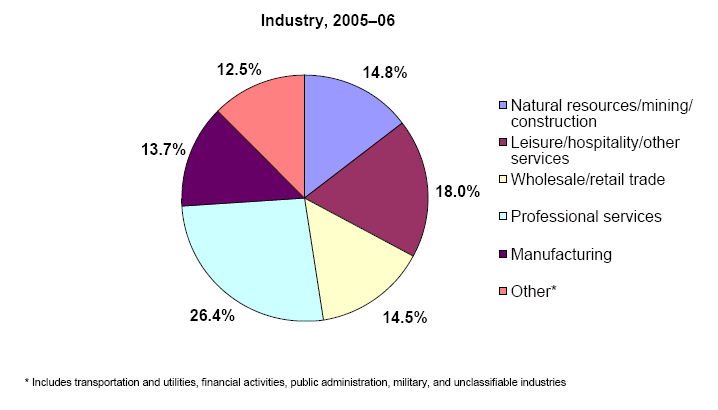
Industry,
2005–06 |
Natural resources/mining/construction |
14.8% |
Leisure/hospitality/other services |
18.0% |
Wholesale/retail trade |
14.5% |
Professional services |
26.4% |
Manufacturing |
13.7% |
Other* |
12.5% |
* Includes transportation and utilities,
financial activities,
public administration, military, and
unclassifiable industries |
Return to Table of Contents
Did the distribution of non-elderly full-time low income workers
across industries change from 1996–97 to 2005–06?
- There were noticeable changes in the distribution of workers across
industry classifications. Both wholesale/retail trade and manufacturing
had declining
shares of workers. The proportion of low income workers in wholesale/retail
trade fell by 7.4 points, from 21.9 percent in 1996–97 to 14.5 percent
in 2005–06 and the proportion in manufacturing fell by 8.1 points
(from 21.8 percent to 13.7 percent). In contrast to this, the proportion
of low income workers in natural resources/mining/construction
increased by 5.1 points (from 9.7 percent to 14.8 percent), the
proportion in leisure/hospitality/"other" services
increased by 5.1 points (from 12.9 percent to 18.0 percent) and
the proportion in professional services increased by 6.4 points
(from 20.0 percent to 26.4
percent).
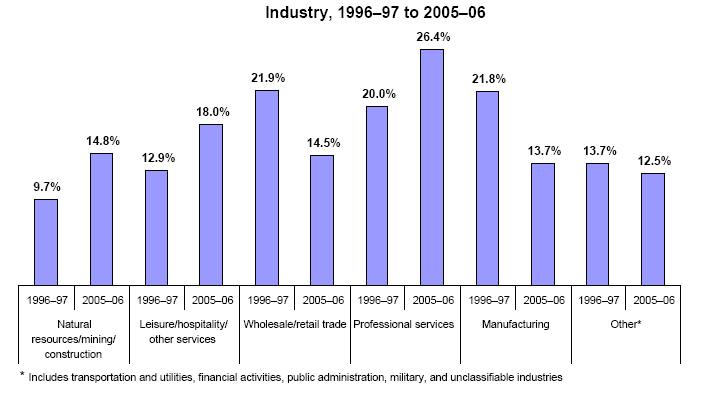
Industry,
1996–97
to 2005–06
|
| |
1996-97 |
2005-06 |
Natural resources/mining/construction |
9.7% |
14.8% |
Leisure/hospitality/other services |
12.9% |
18.0% |
Wholesale/retail trade |
21.9% |
14.5% |
Professional services |
20.0% |
26.4% |
Manufacturing |
21.8% |
13.7% |
Other* |
13.7% |
12.5% |
| * Includes transportation and utilities,
financial activities, public administration, military, and
unclassifiable industries |
Return to Table of Contents
Section 3: Health
Insurance Status of Non-elderly Full-time Low Income Workers
by Demographic, Health, and Job Characteristics
As
in Section 2, this section focuses exclusively on our population of
interest, non-elderly, full-time low income workers. This group comprises
non-elderly adults (ages 18 to 64) who were employed full time for
the entire year, who were not self-employed and whose family income
was less than 200 percent of the Federal Poverty Line (FPL). This
section examines the health insurance coverage of full-time low income
workers within groups of low income workers defined by demographic
characteristics, health status, and job characteristics. We begin
by examining health insurance coverage in 2005–06 and then examine
trends in coverage from 1996–97 to 2005–06.
Did the insurance status of non-elderly full-time low income workers
vary by age in 2005–06?
- The 18 to 34 age group (51.0 percent) was less likely to have any private
health insurance compared to the 35 to 49 age group (58.7 percent)
or the 50 to 64 group (62.4 percent).
- The 50 to 64 age group (7.2 percent)
was less likely to have public insurance only than the 18 to
34 age group (10.8 percent).
- Nearly 2.1 million persons or 38.2 percent of the 18 to 34 age group
were uninsured for the entire year. This was a larger percentage of uninsured
than the 35 to 49 age group (32.3 percent) or the 50 to 60
age group (30.4
percent).
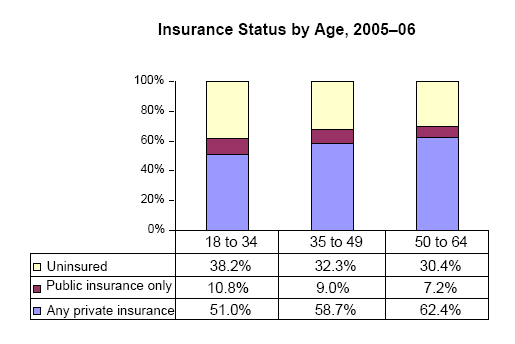
Insurance
Status by Age, 2005–06
|
| |
18 to 34 |
35 to 49 |
50 to 64 |
Uninsured
|
38.2% |
32.3% |
30.4% |
Public insurance only
|
10.8% |
9.0% |
7.2% |
Any private insurance
|
51.0% |
58.7% |
62.4% |
Return to Table of Contents
Did the insurance
status of non-elderly full-time low income workers within age groups change
between
1996–97 and 2005–06?
- In the youngest age group (ages 18 to 34), the proportion with private
coverage fell by 9.8 points and the proportion of uninsured
increased by 8.5 points.
- In the middle age group (ages 35 to 49), the proportion with private
coverage fell by 13.1 points, the proportion with public coverage increased
by 2.8
points and the proportion of uninsured increased by 10.3 points.
- In the oldest age group (ages 50 to 64), the proportion with private
coverage decreased by 9.1 points and the proportion with public coverage
increased
by 3.7 points.
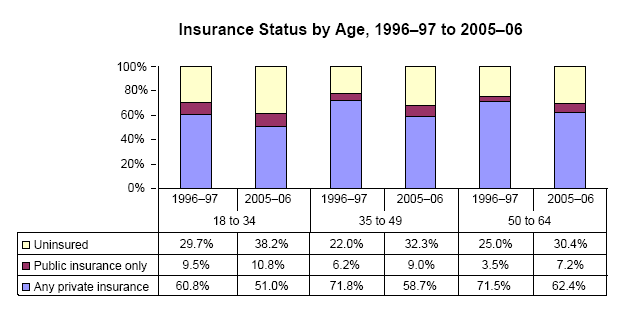
Insurance
Status by Age, 1996–97 to 2005–06
|
| |
1996-97
18 to 34 |
2005-06
18 to 34 |
1996-97
35 to 49 |
2005-06
35 to 49 |
1996-97
50 to 64 |
2005-06
50 to 64 |
Uninsured
|
29.7% |
38.2% |
22.0% |
32.3% |
25.0% |
30.4% |
Public insurance only
|
9.5% |
10.8% |
6.2% |
9.0% |
3.5% |
7.2% |
Any private insurance
|
60.8% |
51.0% |
71.8% |
58.7% |
71.5% |
62.4% |
Return to Table of Contents
Did the insurance status of non-elderly full-time low income workers
vary by race/ethnicity in 2005–06?
- Hispanic workers were significantly less likely than others to have
any private health insurance. Only 40.2 percent of Hispanics had any private
coverage, compared to 63.9 percent for black non-Hispanics
and 63.6 percent
for white/other non-Hispanics.
- There were no statistically significant differences between the racial/ethnic
groups regarding public health insurance.
- Hispanic workers (49.0 percent) were nearly twice as likely to be uninsured
as black non-Hispanic or white/other non-Hispanic workers (27.4
percent and 27.7 percent, respectively). An average annual total of 4.6
million
low income workers were uninsured in 2005–06. This total comprised
nearly 2.1 million Hispanic, 0.6 million black non-Hispanic,
and 1.9 million white/other non-Hispanic low income workers.
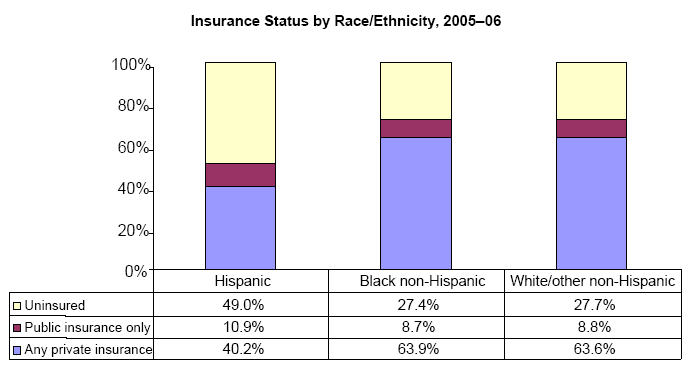
Insurance
Status by Race/Ethnicity, 2005–06
|
| |
Hispanic |
Black non-Hispanic |
White/
other non-Hispanic |
Uninsured
|
49.0% |
27.4% |
27.7% |
Public insurance only
|
10.9% |
8.7% |
8.8% |
Any private insurance
|
40.2% |
63.9% |
63.6% |
Return to Table of Contents
Did
the insurance status of non-elderly full-time low income workers within
racial/ethnic
groups change from 1996–97 and 2005–06?
- All racial/ethnic groups had significant decreases in the percentage
with any private health insurance. For Hispanic workers, the
proportion with private insurance declined by 9.2 points, from 49.4
percent in 1996–97
to 40.2 percent in 2005–06. For black non-Hispanic workers, the
proportion with private insurance declined by 9.1 points (from
73.0 percent to 63.9 percent) while for white/other non-Hispanics this
proportion
declined by 7.8 points (71.4 to 63.6 percent).
- Hispanic workers experienced an increase of 3.6 points in the percentage
with public coverage, from 7.3 percent in 1996–97 to 10.9 percent
in 2005–06.
- Both black non-Hispanic and white/other non-Hispanic
workers experienced increases in the percentage uninsured (9.9
and 5.9 point increase, respectively).
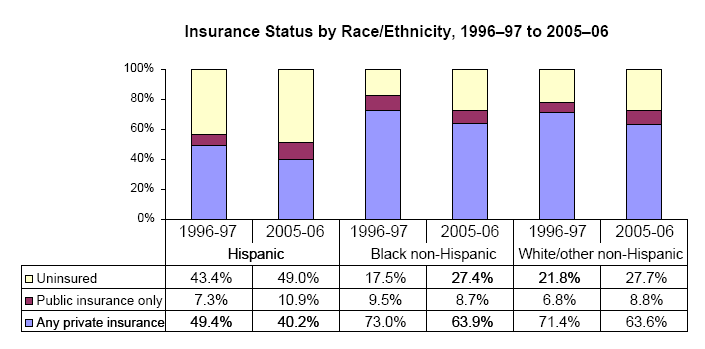
Insurance
Status by Race/Ethnicity, 1996–97 to 2005–06
|
| |
1996-97
Hispanic |
2005-06
Hispanic |
1996-97
Black
non-Hispanic |
2005-06
Black
non-Hispanic |
1996-97
White/
other
non-Hispanic |
2005-06
White/
other
non-Hispanic |
Uninsured
|
43.4% |
49.0% |
17.5% |
27.4% |
21.8% |
27.7% |
Public insurance only
|
7.3% |
10.9% |
9.5% |
8.7% |
6.8% |
8.8% |
Any private insurance
|
49.4% |
40.2% |
73.0% |
63.9% |
71.4% |
63.6% |
Return to Table of Contents
Did the insurance status of non-elderly full-time low income
workers vary by sex in 2005–06?
- Men (50.6 percent) were significantly less likely to have any private
health insurance than women (63.5 percent).
- Men (7.8 percent) were also less likely to have public health insurance
than women (11.6 percent).
- Men (41.6 percent) were more likely to be uninsured than women (24.9
percent).

Insurance
Status by Sex, 2005–06
|
| |
Male |
Female |
Uninsured
|
41.6% |
24.9% |
Public insurance only
|
7.8% |
11.6% |
Any private insurance
|
50.6% |
63.5% |
Return to Table of Contents
Did the insurance status of men and women who were non-elderly
full-time low income workers change between 1996–97 and 2005–06?
- Both men and women had significant decreases in private health
insurance. The proportion of men with private coverage declined
by 11.3 points,
from 61.9 percent in 1996–97 to 50.6 percent in 2005–06
and the proportion for women declined by 8.7 points (from 72.2
percent to 63.5 percent).
- Men had an increase of 2.6 points in the proportion with public
health insurance, from 5.2 percent to 7.8 percent.
- Both men and women had significant increases in the percentage
of uninsured, with the proportion of uninsured men increasing by
8.6
points (from 33.0 percent to 41.6 percent), and the proportion
of women increasing by 7.3 points (from 17.6 percent to 24.9 percent).

Insurance
Status by Sex, 1996–97 to 2005–06
|
| |
1996-97
Male |
2005-06
Male |
1996-97
Female |
2005-06
Female |
Uninsured
|
33.0% |
41.6% |
17.6% |
24.9% |
Public insurance only
|
5.2% |
7.8% |
10.2% |
11.6% |
Any private insurance
|
61.9% |
50.6% |
72.2% |
63.5% |
Return to Table of Contents
Did the insurance status of non-elderly full-time low income
workers vary by education in 2005–06?
- The proportion of full-time low income workers with private insurance
increased with education as 41.1 percent of workers with less
than a high school education, 61.1 percent of high school graduates,
and
68.6 percent of workers with at least some college were covered
by private insurance in 2005–06.
- By contrast, the proportion of full-time low income workers with
public insurance declined with education as 12.8 percent of
workers with less than a high school education, 8.5 percent of
high school
graduates, and 6.5 percent of workers with at least some college
were covered by public insurance in 2005–06.
- The
proportion of full-time low income workers with no health insurance
also declined across the three education categories. About 2.1
million low income workers (46.2 percent) with less than a high
school diploma
were uninsured, compared to 30.4 percent of high school graduates,
and 24.9 percent of those with at least some college.
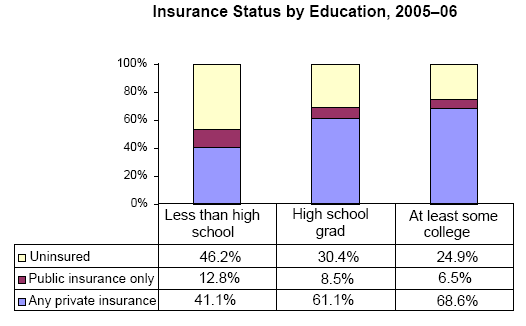
Insurance
Status by Education, 2005–06
|
| |
Less than high school |
High school grad |
At least some college |
Uninsured
|
46.2% |
30.4% |
24.9% |
Public insurance only
|
12.8% |
8.5% |
6.5% |
Any private insurance
|
41.1% |
61.1% |
68.6% |
Return to Table of Contents
Did
the insurance status of non-elderly full-time low income workers
within education groups change between 1996–97 and 2005–06?
- All educational groups experienced significant declines in the
proportion of workers with private health insurance. For workers
with less than
a high school diploma the percentage with private coverage declined
by 10.3 points, from 51.4 percent in 1996–97 to 41.1 percent
in 2005–06. The proportion for high school graduates declined
by 7.6 points (from 68.7 percent to 61.1 percent) and the proportion
for workers with at least some college declined by 8.9 points
(from 77.5 percent to 68.6 percent).
- None of the educational groups had a statistically significant
change in the percentage with public health insurance.
- All educational groups experienced a significant increase in the
proportion of workers with no health insurance. For workers with
less than a high school diploma the percentage uninsured increased
by 7.4
points, from 38.8 percent in 1996–97 to 46.2 percent in 2005–06.
The proportion for high school graduates increased by 6.8 points
(from 23.6 percent to 30.4 percent) and the proportion for workers
with
at least some college increased by 7.1 points (from 17.8 percent
to 24.9 percent).
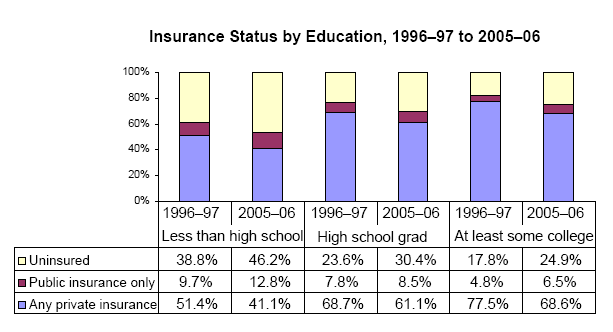
Insurance
Status by Education, 1996–97 to 2005–06
|
| |
1996-97
Less than
high school |
2005-06
Less than
high school |
1996-97
High school
grad |
2005-06
High school
grad |
1996-97
At least
some college |
2005-06
At least
some college |
Uninsured
|
38.8% |
46.2% |
23.6% |
30.4% |
17.8% |
24.9% |
Public insurance only
|
9.7% |
12.8% |
7.8% |
8.5% |
4.8% |
6.5% |
Any private insurance
|
51.4% |
41.1% |
68.7% |
61.1% |
77.5% |
68.6% |
Return to Table of Contents
Did the insurance status of non-elderly full-time low income
workers vary by marital status in 2005–06?
- There were no statistically significant differences in insurance
status between married and unmarried low income workers.
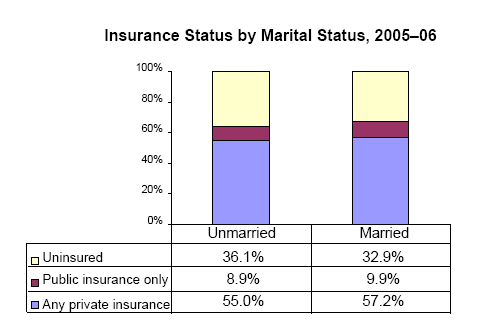
Insurance
Status by Marital Status, 2005–06
|
| |
Unmarried |
Married |
Uninsured
|
36.1% |
32.9% |
Public insurance only
|
8.9% |
9.9% |
Any private insurance
|
55.0% |
57.2% |
Return to Table of Contents
Did the insurance status of non-elderly full-time low income
workers that were married or unmarried change between 1996–97 and 2005–06?
- Workers that were unmarried had a decline of 9.5 points in the
percentage with private health insurance, declining from 64.5 percent
in 1995-97
to 55.0 percent in 2005–06. This group also saw an increase
of 9.0 points in the proportion lacking any health insurance
coverage (from 27.1 percent to 36.1 percent).
- Married workers also saw a decline in the percentage with private
coverage (11.4 points, from 68.6 percent to 57.2 percent),
an increase of 3.5 points in the proportion with public coverage
(from 6.4 percent
to 9.9 percent), and an increase of 7.9 points in the proportion
of uninsured (from 25.0 percent to 32.9 percent).
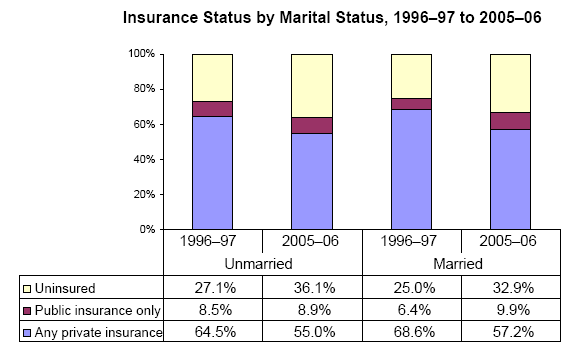
Insurance
Status by Marital Status, 1996–97 to 2005–06
|
| |
1996-97
Unmarried |
2005-06
Unmarried |
1996-97
Married |
2005-06
Married |
Uninsured
|
27.1% |
36.1% |
25.0% |
32.9% |
Public insurance only
|
8.5% |
8.9% |
6.4% |
9.9% |
Any private insurance
|
64.5% |
55.0% |
68.6% |
57.2% |
Return to Table of Contents
Did the insurance status of non-elderly full-time low income
workers vary by family size in 2005–06?
- Workers in single person units (51.2 percent) were less likely
to have private health insurance compared to workers in two person
families
(61.4 percent).
- Workers in one or two person families (4.0 percent and 6.8 percent,
respectively) were less likely than workers in families with
three, or four or more, persons to have public coverage (14.1 percent
and
10.8 percent, respectively).
- Workers in single person families (44.8 percent) were more likely
to be uninsured than workers in families with two persons (31.8
percent), three persons (30.1 percent) or four or more persons (33.3
percent).

Insurance
Status by Family Size, 2005–06
|
| |
1 |
2 |
3 |
4 or more |
Uninsured
|
44.8% |
31.8% |
30.1% |
33.3% |
Public insurance only
|
4.0% |
6.8% |
14.1% |
10.8% |
Any private insurance
|
51.2% |
61.4% |
55.8% |
55.9% |
Return to Table of Contents
Did the insurance status of non-elderly full-time low
income workers within family size categories change from 1996–97 to 2005–06?
- Workers in single person families and families with four or more
family members both saw declines in the percentage with private
health insurance (declines of 14.2 points and 11.9 points, respectively).
These two groups also had increases in the proportion of uninsured
(increases of 14.9 points and 8.9 points, respectively).
- Workers in families with four or more members were the only
group to have a significant increase in the percentage with public
coverage
only, increasing by 3.0 points, from 7.8 percent in 1996–97
to 10.8 percent in 2005–06.
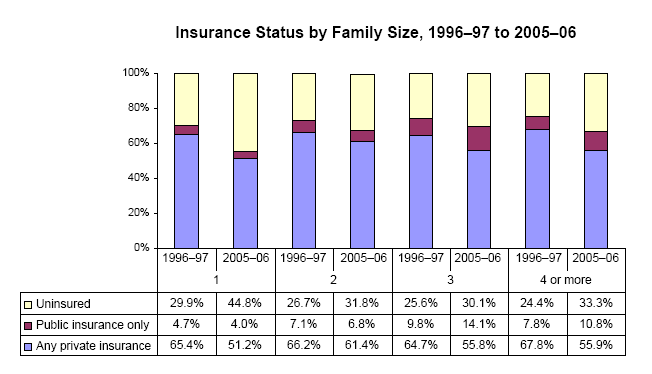
Insurance
Status by Family Size, 1996–97 to 2005–06
|
| |
1996-97
1 |
2005-06
1 |
1996-97
2 |
2005-06
2 |
1996-97
3 |
2005-06
3 |
1996-97
4 or more |
2005-06
4 or more |
Uninsured
|
29.9% |
44.8% |
26.7% |
31.8% |
25.6% |
30.1% |
24.4% |
33.3% |
Public insurance only
|
4.7% |
4.0% |
7.1% |
6.8% |
9.8% |
14.1% |
7.8% |
10.8% |
Any private insurance
|
65.4% |
51.2% |
66.2% |
61.4% |
64.7% |
55.8% |
67.8% |
55.9% |
Return to Table of Contents
Did the insurance status of non-elderly full-time low
income workers vary by health status in 2005–06?
- There were no statistically significant differences in the health
insurance status for workers based on their self-reported health
status during these two time periods.

Insurance
Status by Perceived Health Status, 2005–06
|
| |
Excellent/
very good/
good |
Fair/poor |
Uninsured
|
34.8% |
31.9% |
Public insurance only
|
9.1% |
12.4% |
Any private insurance
|
56.1% |
55.7% |
Return to Table of Contents
Did the insurance coverage of non-elderly full-time low
income workers change within health status groups from 1996–97 to
2005–06?
- Workers in excellent, very good, or good health saw significant
declines in the percentage having private health insurance, declining
by 11.1 points, from 67.2 percent in 1996–97 to 56.1 percent
in 2005–06. These workers also had a 2.3 point increase
in the percentage with public coverage (from 6.8 percent to 9.1
percent)
and an 8.8 point increase in the percentage of uninsured (from
26.0 percent to 34.8 percent).
- Workers in fair or poor
health did not have any statistically significant changes in
this
time
period.
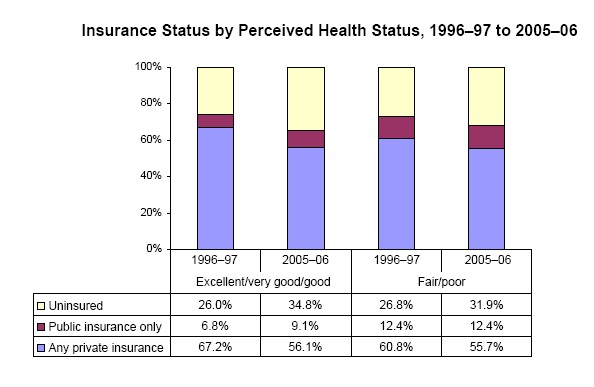
Insurance
Status by Perceived Health Status, 1996–97 to 2005–06
|
| |
1996-97
Excellent/
very good/
good |
2005-06
Excellent/
very good/
good |
1996-97
Fair/poor |
2005-06
Fair/poor |
Uninsured
|
26.0% |
34.8% |
26.8% |
31.9% |
Public insurance only
|
6.8% |
9.1% |
12.4% |
12.4% |
Any private insurance
|
67.2% |
56.1% |
60.8% |
55.7% |
Return to Table of Contents
Did the
insurance status of non-elderly full-time low income workers
vary by MSA
status in 2005–06?
- Workers living in an MSA were less likely than workers living
in non-MSAs to have private health insurance (54.1 percent and
63.7 percent, respectively) and more likely to have public coverage
(10.5 percent and 5.4 percent, respectively).
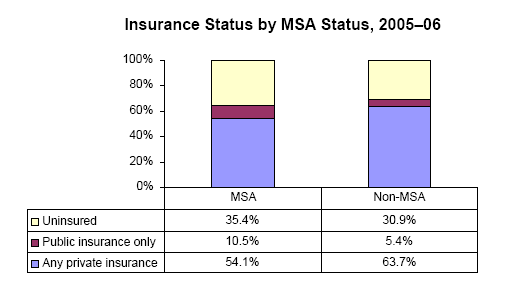
Insurance
Status by MSA Status, 2005–06
|
| |
MSA |
Non-MSA |
Uninsured
|
35.4% |
30.9% |
Public insurance only
|
10.5% |
5.4% |
Any private insurance
|
54.1% |
63.7% |
Return to Table of Contents
Did the insurance status of non-elderly full-time low
income workers in an MSA or non-MSA change from 1996–97 to 2005–06?
- Workers living in an MSA had an 11.7 point decrease in the
percentage with private health insurance, from 65.8 percent in
1996–97
to 54.1 percent in 2005–06. This group also had an increase
of 9.6 points in the percentage of uninsured (from 25.8 percent
to 35.4 percent).
- Workers not living in an MSA had no statistically significant
changes in insurance status in these two time periods.
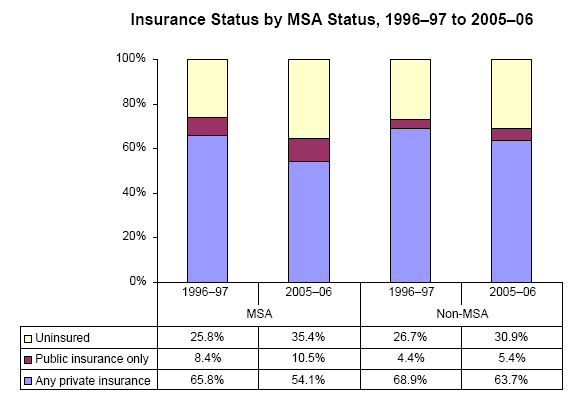
Insurance
Status by MSA Status, 1996–97 to 2005–06
|
| |
1996-97
MSA |
2005-06
MSA |
1996-97
Non-MSA |
2005-06
Non-MSA |
Uninsured
|
25.8% |
35.4% |
26.7% |
30.9% |
Public insurance only
|
8.4% |
10.5% |
4.4% |
5.4% |
Any private insurance
|
65.8% |
54.1% |
68.9% |
63.7% |
Return to Table of Contents
Did the insurance status of non-elderly low income workers
vary by Census region in 2005–06?
- Full-time low income workers living in the West were less likely
to have private health insurance than workers living in the
Northeast, Midwest or South (48.0 percent, compared to 60.2 percent,
60.5
percent, and 57.2 percent, respectively).
- Only 4.6 percent of full-time low income workers living in
the South had public coverage, compared to 13.6 percent living
in the
Northeast, 9.7 percent living in the Midwest, and 15.8 percent
living in the West.
- Full-time low income workers living in the South were more
likely to be uninsured (38.2 percent), than workers living in
the Northeast
or Midwest (26.2 percent and 29.8 percent respectively).
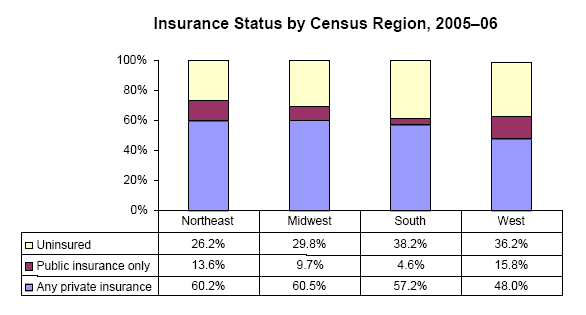
Insurance
Status by Census Region, 2005–06
|
| |
Northeast |
Midwest |
South |
West |
Uninsured
|
26.2% |
29.8% |
38.2% |
36.2% |
Public insurance only
|
13.6% |
9.7% |
4.6% |
15.8% |
Any private insurance
|
60.2% |
60.5% |
57.2% |
48.0% |
Return to Table of Contents
Did the insurance status of non-elderly low income workers
by Census region change from 1996–97 to 2005–06?
- Full-time low income workers living in the Northeast did not
have any statistically significant changes in health insurance
status
in these two time periods.
- Full-time low income workers living in the Midwest had a decrease
of 11.0 points in the proportion with private coverage (from
71.5 percent to 60.5 percent) and a 9.4 point increase in the
proportion
of uninsured (from 20.4 percent to 29.8 percent).
- Full-time low income workers living in the South had a 12.3
point decrease in the percentage with private coverage (from
69.5 percent
to 57.2 percent) and an increase of 12.2 points in the percentage
of uninsured (from 26.0 percent to 38.2 percent).
- Full-time low income workers living in the West had an increase
of 5.0 points in the proportion with public coverage (from
10.8 percent to 15.8 percent).
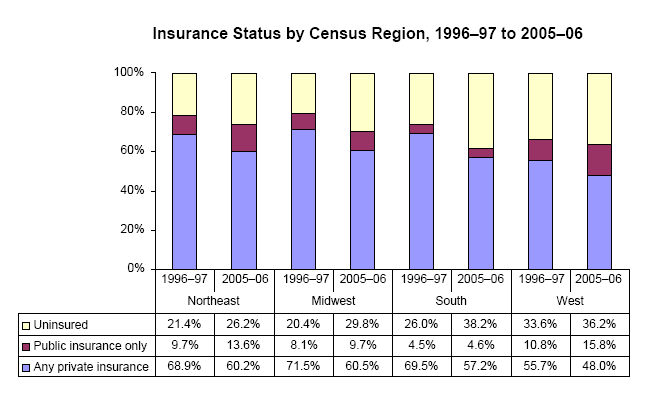
Insurance
Status by Census Region, 1996–97 to 2005–06
|
| |
1996-97
Northeast |
2005-06
Northeast |
1996-97
Midwest |
2005-06
Midwest |
1996-97
South |
2005-06
South
|
1996-97
West |
2005-06
West |
Uninsured
|
21.4% |
26.2% |
20.4% |
29.8% |
26.0% |
38.2% |
33.6% |
36.2% |
Public insurance only
|
9.7% |
13.6% |
8.1% |
9.7% |
4.5% |
4.6% |
10.8% |
15.8% |
Any private insurance
|
68.9% |
60.2% |
71.5% |
60.5% |
69.5% |
57.2% |
55.7% |
48.0% |
Return to Table of Contents
Did the insurance status of non-elderly full-time low
income workers vary by citizenship status in 2005–06?
- Workers that were U.S. citizens were more likely than non-citizen
workers to have private health insurance (63.6 percent and 32.6
percent, respectively) and less likely to be uninsured (27.8 percent
and 55.4 percent, respectively).

Insurance
Status by Citizenship Status, 2005–06
|
| |
Non-citizen |
U.S. citizen |
Uninsured
|
55.4% |
27.8% |
Public insurance only
|
12.0% |
8.7% |
Any private insurance
|
32.6% |
63.6% |
Return to Table of Contents
Did
the insurance status of non-elderly full-time low income workers
by citizenship status change from 1996–97 to 2005–06?
- Citizen
workers had a decrease of 6.3 points in the percentage
with private health insurance, from 69.9 percent in 1996–97
to 63.6 percent in 2005–06, and an increase of 5.3
points in the percentage of uninsured (from 22.5 percent
to 27.8 percent).
- The percentage of non-citizen workers with private coverage
declined by 12.8 points (from 45.4 percent to 32.6 percent) and
the percentage
with public coverage increased by 5.4 points (from 6.6 percent
to 12.0 percent).

Insurance
Status by Citizenship Status, 1996–97 to 2005–06
|
| |
1996-97
Non-citizen |
2005-06
Non-citizen |
1996-97
U.S.citizen |
2005-06
U.S.citizen |
Uninsured
|
48.0% |
55.4% |
22.5% |
27.8% |
Public insurance only
|
6.6% |
12.0% |
7.6% |
8.7% |
Any private insurance
|
45.4% |
32.6% |
69.9% |
63.6% |
Return to Table of Contents
Did
the insurance status of non-elderly full-time low income workers
vary by union status in 2005–06?
Workers that were union members were more likely than non-union
workers to have private health insurance (87.6 percent and 53.5
percent, respectively), less likely to have public coverage (3.2
percent and 9.9 percent, respectively), and about one-quarter as
likely to be uninsured (9.2 percent and 36.6 percent, respectively).

Insurance
Status by Union Membership, 2005–06
|
| |
Non-union |
Union |
Uninsured
|
36.6% |
9.2% |
Public insurance only
|
9.9% |
3.2% |
Any private insurance
|
53.5% |
87.6% |
Return to Table of Contents
Did the insurance status of non-elderly full-time low
income workers by union status change from 1996–97 to 2005–06?
- Non-union workers experienced an 11.2 point decrease in private
health insurance, from 64.7 percent in 1996–97 to 53.5 percent
in 2005–06. This group also had an increase of 2.4 points
in public coverage (from 7.5 percent to 9.9 percent) and an 8.8
point increase in those that were uninsured (from 27.8 percent
to 36.6 percent).
- Workers that were union members did not have any statistically
significant changes in their insurance status in this time period.
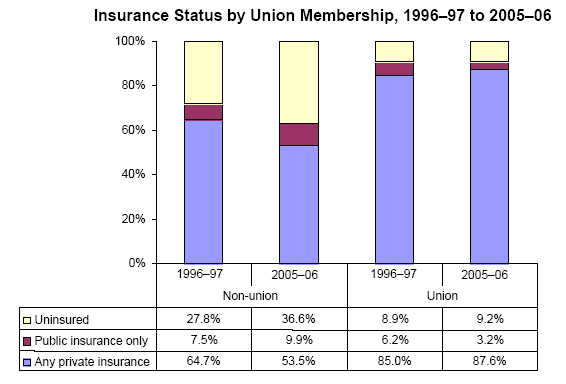
Insurance
Status by Union Membership, 1996–97 to 2005–06
|
| |
1996-97
Non-union |
2005-06
Non-union |
1996-97
Union |
2005-06
Union |
Uninsured
|
27.8% |
36.6% |
8.9% |
9.2% |
Public insurance only
|
7.5% |
9.9% |
6.2% |
3.2% |
Any private insurance
|
64.7% |
53.5% |
85.0% |
87.6% |
Did the insurance status
of non-elderly full-time low income workers vary by establishment
size in 2005–06?
- Full-time low income workers in establishments with fewer than
25 employees were less likely than workers in establishments with
25 to 99, or 100 or more, workers to have private health insurance
(39.4 percent compared to 58.1 percent and 79.4 percent, respectively)
and more likely to be uninsured (49.7 percent compared to 31.3
percent and 14.4 percent, respectively). This group was also more
likely to have public coverage than workers in establishments with
100 or more employees (10.9 percent and 6.2 percent, respectively).
- Full-time low income workers in medium sized establishments
(25–99
employees) were less likely than workers in large establishments
(100 or more employees) to have private coverage (58.1 percent
and 79.4 percent, respectively), more likely to have public
coverage (10.6 percent and 6.2 percent, respectively) and more
likely to
be uninsured (31.3 percent and 14.4 percent, respectively).
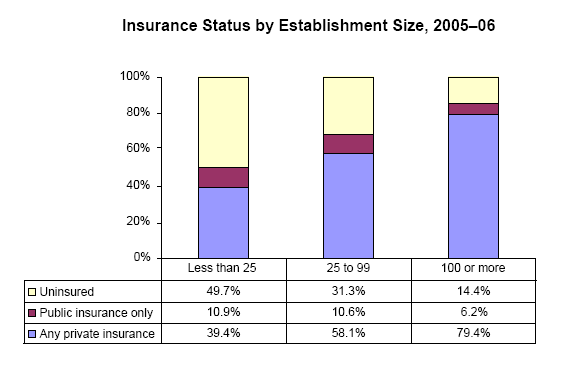
Insurance
Status by Establishment Size, 2005–06
|
| |
Less than 25 |
25 to 99 |
100 or more |
Uninsured
|
49.7% |
31.3% |
14.4% |
Public insurance only
|
10.9% |
10.6% |
6.2% |
Any private insurance
|
39.4% |
58.1% |
79.4% |
Return to Table of Contents
Did the insurance status of non-elderly full-time low
income workers by establishment size change from 1996–97 to 2005–06?
- Full-time low income workers in all establishment sizes had
decreases in the proportions with private health insurance. The
proportion
of workers in small establishments who had private insurance
fell by 12.5 points (from 51.9 percent to 39.4 percent), while
the proportions
for workers in medium size establishments declined by 11.4
points (from 69.5 percent to 58.1 percent), and for workers in
large establishments
fell by 5.5 points (from 84.9 percent to 79.4 percent).
- None of these groups had a statistically significant change
in the percentage with public health insurance.
- The percentage of uninsured increased for workers in small
and medium establishment sizes. The proportion of workers who
were
uninsured increased by 10.8 points (from 38.9 percent to 49.7
percent) in small establishments and by 9.2 points (from 22.1
percent to
31.3 percent) in medium sized establishments.
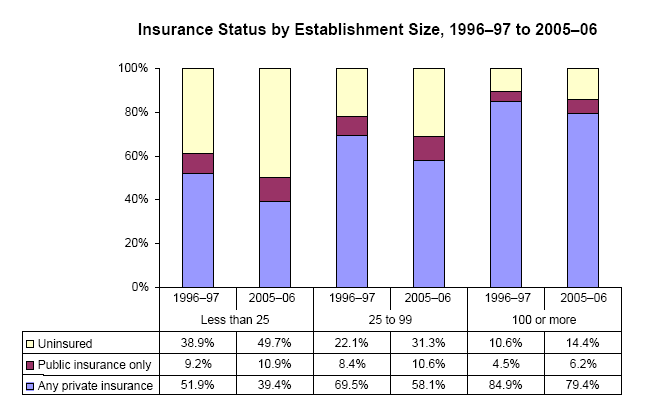
Insurance
Status by Establishment Size, 1996–97 to 2005–06
|
| |
1996-97
Less than 25 |
2005-06
Less than 25 |
1996-97
25 to 99 |
2005-06
25 to 99 |
1996-97
100 or more |
2005-06
100 or more |
Uninsured
|
38.9% |
49.7% |
22.1% |
31.3% |
10.6% |
14.4% |
Public insurance only
|
9.2% |
10.9% |
8.4% |
10.6% |
4.5% |
6.2% |
Any private insurance
|
51.9% |
39.4% |
69.5% |
58.1% |
84.9% |
79.4% |
Return to Table of Contents
Did the insurance status of non-elderly full-time low
income workers vary by industry in 2005–06?
- Full-time low income workers employed in natural resources/mining/construction
(34.1 percent) or leisure/hospitality/other services (40.4 percent)
were less likely to have private health insurance than workers
employed in other industries.
- Full-time low income workers employed in leisure/hospitality/other
services were more likely to have public coverage (12.7 percent)
than workers employed in professional services (8.8 percent), manufacturing
(7.8 percent), and "other" industries (6.8 percent).
- More than half (55.4 percent) of full-time low income workers
employed in natural resources/mining/construction were uninsured.
This was a higher percentage than workers in any other industry
category.
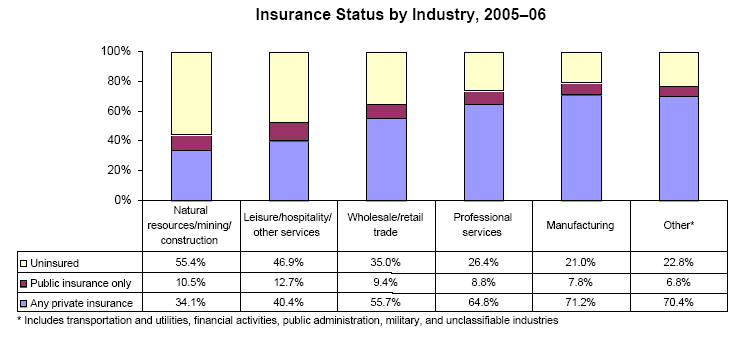
Insurance
Status by Industry, 2005–06
|
| |
Uninsured |
Public insurance only |
Any private insurance |
Natural resources/mining/construction
|
55.4% |
10.5% |
34.1% |
Leisure/hospitality/other
services
|
46.9% |
12.7% |
40.4% |
Wholesale/retail trade
|
35.0% |
9.4% |
55.7% |
Professional services
|
26.4% |
8.8% |
64.8% |
Manufacturing
|
21.0% |
7.8% |
71.2% |
Other*
|
22.8% |
6.8% |
70.4% |
| * Includes transportation and utilities,
financial activities, public administration, military, and
unclassifiable industries |
Return to Table of Contents
Did the insurance status of non-elderly full-time low
income workers by industry change from 1996–97 to 2005–06?
- Full-time low income employed in natural resources/mining/construction
had an 18.3 points decrease in the proportion with private coverage,
from 52.4 percent in 1996–97 to 34.1 percent in 2005–06,
and a 13.3 point increase in the percentage of uninsured (from
42.1 percent to 55.4 percent).
- Full-time low income employed in leisure/hospitality/other
services had a 12.7 point decrease in the percentage with private
coverage
(from 53.1 percent to 40.4 percent) and a 5.5 point increase
in the percentage with public coverage (from 7.2 percent to 12.7
percent).
- Full-time low income employed in professional services had
a 14.5 point decline in the proportion with private coverage
(from 79.3
percent to 64.8) and an increase of 14.9 points in the proportion
of uninsured (from 11.5 percent to 26.4 percent).
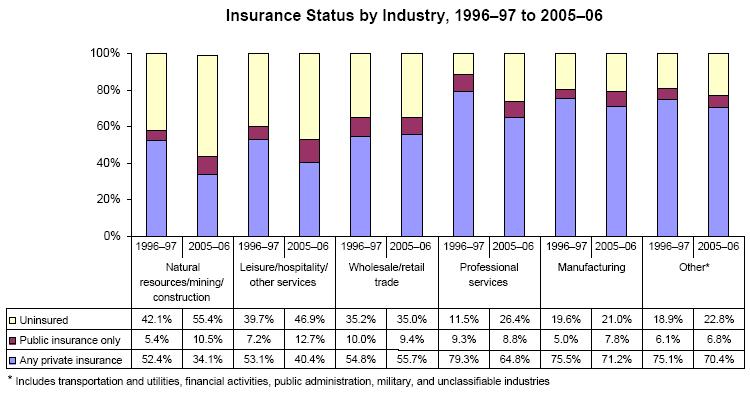
Insurance
Status by Industry, 1996–97 to 2005–06
|
| |
1996-97
Uninsured |
2005-06
Uninsured |
1996-97
Public insurance only |
2005-06
Public insurance only |
1996-97
Any private insurance |
2005-06
Any private insurance |
Natural resources/mining/construction
|
42.1% |
55.4% |
5.4% |
10.5% |
52.4% |
34.1% |
Leisure/hospitality/other
services
|
39.7% |
46.9% |
7.2% |
12.7% |
53.1% |
40.4% |
Wholesale/retail trade
|
35.2% |
35.0% |
10.0% |
9.4% |
54.8% |
55.7% |
Professional services
|
11.5% |
26.4% |
9.3% |
8.8% |
79.3% |
64.8% |
Manufacturing
|
19.6% |
21.0% |
5.0% |
7.8% |
75.5% |
71.2% |
Other*
|
18.9% |
22.8% |
6.1% |
6.8% |
75.1% |
70.4% |
| * Includes transportation and utilities,
financial activities, public administration, military, and
unclassifiable industries |
Return to Table of Contents
Did the insurance status of non-elderly full-time low
income workers vary by hourly wage in 2005–06?
- Workers in the lowest wage quartile (first) were less likely
to have private health insurance than workers in higher wage
quartiles
(37.7 percent compared to 53.0 percent, 68.3 percent, and 71.0
percent, respectively). Workers in the second wage quartile
were also less likely to have private coverage than workers
in higher
wage quartiles.
- Workers in the lowest wage quartile were more likely to have
public coverage than the other groups (13.8 percent compared
to 11.4 percent,
7.1 percent and 4.0 percent, respectively). Workers in the
second wage quartile were also more likely to have public coverage
than
workers in higher wage quartiles.
- Workers in the lowest wage quartile were more likely to be
uninsured than workers in higher wage quartiles (48.6 percent
compared to
35.6 percent, 24.6 percent and 25.0 percent, respectively).
Workers in the second wage quartile were also more likely to
be uninsured
than workers in higher wage quartiles.
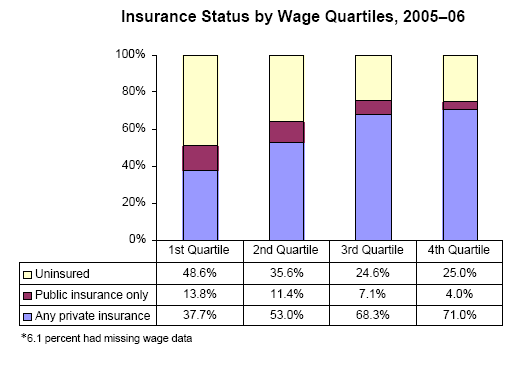
Insurance
Status by Wage Quartiles, 2005–06
|
| |
1st Quartile |
2nd Quartile |
3rd Quartile |
4th Quartile |
Uninsured
|
48.6% |
35.6% |
24.6% |
25.0% |
Public insurance only
|
13.8% |
11.4% |
7.1% |
4.0% |
Any private insurance
|
37.7% |
53.0% |
68.3% |
71.0% |
*6.1 percent had missing wage data |
Return to Table of Contents
Did the insurance status of non-elderly full-time low
income workers, by hourly wage, change from 1996–97 to 2005–06?
- Workers in the first wage quartile had a decline of 8.2 points
in the percentage with private health insurance, from 45.9 percent
in 1996–97 to 37.7 percent in 2005–06. This group
also had a 9.7 point increase in the percentage of uninsured
(from 38.9
percent to 48.6 percent).
- Workers in the second wage quartile had a 15.6 point decline
in the proportion with private coverage (from 68.6 percent
to 53.0 percent), an increase of 4.8 points in the percentage
with public
coverage (from 6.6 percent to 11.4 percent) and a 10.8 point
increase in the percentage of uninsured (from 24.8 percent to
35.6 percent).
- Workers in the fourth wage quartile had a decline of 9.2 points
in the percentage with private coverage (from 80.2 percent
to 71.0 percent) and an increase of 7.7 points in the percentage
of uninsured
(from 17.3 percent to 25.0 percent).
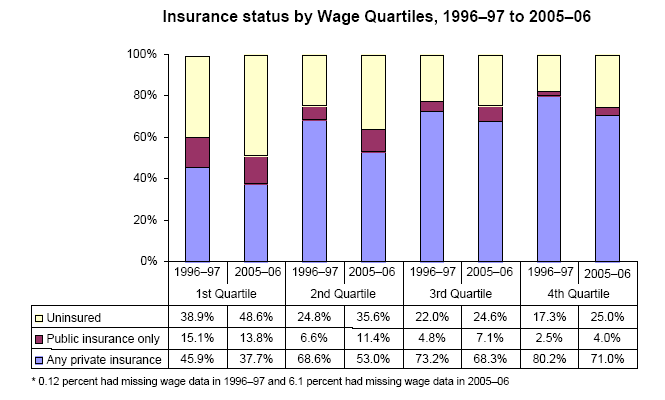
Insurance
Status by Wage Quartiles, 1996–97 to 2005–06
|
| |
1996-97
1st Quartile |
2005-06
1st Quartile |
1996-97
2nd Quartile |
2005-06
2nd Quartile |
1996-97
3rd Quartile |
2005-06
3rd Quartile |
1996-97
4th Quartile |
2005-06
4th Quartile |
Uninsured
|
38.9% |
48.6% |
24.8% |
35.6% |
22.0% |
24.6% |
17.3% |
25.0% |
Public insurance only
|
15.1% |
13.8% |
6.6% |
11.4% |
4.8% |
7.1% |
2.5% |
4.0% |
Any private insurance
|
45.9% |
37.7% |
68.6% |
53.0% |
73.2% |
68.3% |
80.2% |
71.0% |
* 0.12 percent had
missing wage data in 1996–97 and 6.1 percent had
missing wage data in 2005–06
|
Return to Table of Contents
References
Collins SR, Schoen C, Colasanto D and Downey, DA. On the Edge:
Low-Wage Workers and Their Health Insurance Coverage: Findings
from the Commonwealth Fund 2001 Health Insurance Survey. 2003 (April).
Vistnes JP, Schone BS. Pathways to Coverage: The Changing
Roles of Public and Private Sources. Health Affairs 2008 (Jan./Feb.);
27(1): 44-56.
Yu CS and Long SK. What’s Driving the Downward
Trend in Employer-Sponsored Health Insurance? Health Services
Research 2006 (December) 41(6):2074-2094.
Return to Table of Contents
Definition of Terms
Age
Defined using the last available age for each sampled person. Census
region
Each MEPS sampled person was classified as living in one
of the following four regions as defined by the U.S. Census Bureau.
- Northeast—Maine, New Hampshire, Vermont, Massachusetts,
Rhode Island, Connecticut, New York, New Jersey, and Pennsylvania.
- Midwest—Ohio,
Indiana, Illinois, Michigan, Wisconsin, Minnesota, Iowa,
Missouri, South Dakota, North Dakota, Nebraska, and Kansas.
- South—Delaware,
Maryland, District of Columbia, Virginia, West Virginia,
North Carolina, South Carolina, Georgia, Florida, Kentucky, Tennessee,
Alabama, Mississippi, Arkansas, Louisiana, Oklahoma, and
Texas.
- West—Montana, Idaho, Wyoming, Colorado, New Mexico, Arizona,
Utah, Nevada, Washington, Oregon, California, Alaska, and
Hawaii.
Citizen
The MEPS does not include questions about citizenship.
This data was merged onto the MEPS from the previous years’ NHIS,
from which MEPS respondents are drawn. Citizenship status in the
NHIS is reported for all household members by the household respondent.
Education
Measured as the highest level of education each individual
has attained. We use the following three education categories:
- Less
than high school—having less than 12 years of education.
- High school graduate—having 12 years of education.
- At least
some college—having more than 12 years of education.
Education data was missing for 1.0 percent of
cases in 2005–06.
Return to Table of Contents
Establishment
A particular workplace or location. A small establishment
is defined as having fewer than 25 employees; a medium-sized establishment
has 25 to 99 employees; a large establishment has 100 or more employees.
Establishment size was missing for 4.2 percent of cases in 1996–97
and for 8.6 percent of cases in 2005–06. Employee
A person on the actual payroll. This includes temporary and contract
workers but excludes persons that are self-employed.
Employment
status
We use the following employment categories:
- Full-time/full-year—working
full-time (35 or more hours per week) for all 12 months of
the year,
- Part-time/part-year—working less than full-time and
/ or for less than 12 months of the year, and
- Unemployed/not in
the labor force (NLF)—not working at any time during
the year despite searching for employment, or not working any
during
the year and not searching for employment.
Family
A family generally
consists of two or more persons living together in the same household
who are related by blood, marriage, or adoption, as well as foster
children. Other types of family units include unmarried persons
living together who consider and report themselves a family unit
and single persons living with neither a relative nor a person
identified as a “significant other.” Relatives identified
as usual residents of the household who were not present at the
time of the interview, such as college students living away from
their parents’ home during the school year, are considered
as members of the family that identified them. All families with
one or more members living in the community population for any
part of the year are included in the estimates. Family
Income
Income categories are defined by the ratio of family income
to the Federal income thresholds, which control for family
size and age of the head of family. Family income (poverty status)
categories are defined as follows:
- Low income: persons in families
with income less than or equal to 200 percent of the
Federal poverty line including persons with negative income.
- Middle
income:
persons in families with income over 200 percent through
400 percent of the Federal poverty line.
- High income: Persons
in
families with income over 400 percent of the Federal
poverty line.
Return to Table of Contents
Health insurance status
Insurance for each person
is categorized into one of the following three mutually exclusive
categories:
- Any private insurance: this group includes those who,
at any time in the survey year, had individual or group plan
coverage
for medical or related expenses or who were covered
by TRICARE
(formerly CHAMPUS), which covers retired members
of the uniformed services and the spouses and children of active-duty
military.
Private health insurance plans may include prepaid
health
plans
such as health maintenance organizations but they
exclude
extra cash coverage plans, medical benefits linked only
to specific diseases (dread disease plans), and casualty benefit
plans
(such as automobile insurance).
- Public insurance only: this
group includes
persons who were never covered by private insurance
or
TRICARE during the year but who were covered at any time by Medicare,
Medicaid, SCHIP or other State and local medical assistance
programs.
- Uninsured: this group includes all persons who did
not have private or public insurance coverage at any time
in the calendar year.
Industry
Industry categories are defined as follows (Industrial
Classification System Code Value in parentheses):
- Natural resources/mining/construction
includes the industry categories natural resources (0170-0290),
mining (0370-0490) and construction (0770).
- Leisure/hospitality/other
services includes the industry categories leisure and
hospitality (8560-8690), and other services (8770-9290).
- Wholesale/retail
trade includes the industry category wholesale and
retail trade (4070-4590 and 4670-5790).
- Professional services includes
the
industry categories professional and business services
(7270-7790), information (6470-6780) and education, health,
and social
services (7860-8470).
- Manufacturing (1070-3990).
- Other includes
the
industry categories transportation and utilities
(0570-0690 and 6070-6390),
financial activities (6870-7190), public administration
(9370-9590), military (9890), and unclassifiable industries
(9990).
MSA
An MSA is a large population nucleus
combined with adjacent communities that have a high degree of
economic and social integration with the nucleus. Each MSA has
one or more central counties containing the area’s main
population concentration. In New England, metropolitan areas
consist of cities and towns rather than whole counties.
Return to Table of Contents
Non-elderly adult
A person 18 to 64 years of age.
Perceived health status
During each round of interviewing, the
household respondent was asked to rate the health of each person
in the family according to the following categories: excellent,
very good, good, fair, or poor. For this chartbook, the response
categories “excellent,” “very good” and "good" were
collapsed, as were “fair" and “poor.”
Race/ethnicity
Classification by race and ethnicity is mutually
exclusive and based on information reported for each family member.
Respondents were asked if each family member's race was best
described as white, black, Asian, American Indian, Alaska Native,
native Hawaiian or Pacific Islander. In 2005–06, the MEPS
survey was modified to allow reporting of multiple races. All
persons, whose main national origin or ancestry was reported
as Hispanic, regardless of racial background, are classified
as Hispanic. All non-Hispanic persons whose race was reported
as Asian, American Indian, Alaska native, native Hawaiian, or
multiple races (in 2005–06) are classified in the ‘other’ race
category. For this analysis the following classification by race
and ethnicity was used: Hispanic (of any race), black non-Hispanic
and white/other non-Hispanic.
Union
The MEPS records information on whether a person belonged
to a labor union. Union membership had 1.04 percent missing data
in 1996–97 and 1.33 percent missing data in 2005–06.
Wage
Hourly wage was asked of all persons who reported a current
main job that was not self-employment. Wage data were missing
for 0.12 percent of cases in 1996–97 and 6.4 percent of
cases in 2005–06.
Worker
Same as employee. Return to Table of Contents
Suggested Citation:
William A. Carroll, MA and G. Edward
Miller, PhD. Chartbook #18: Full-Time Poor and Low
Income Workers: Demographic Characteristics and Trends in Health Insurance Coverage,
1996–97 to 2005–06. Rockville, MD: Agency for
Healthcare Research and Quality, June 2009.
http://www.meps.ahrq.gov/data_files/publications/cb18/cb18.shtml |
|
